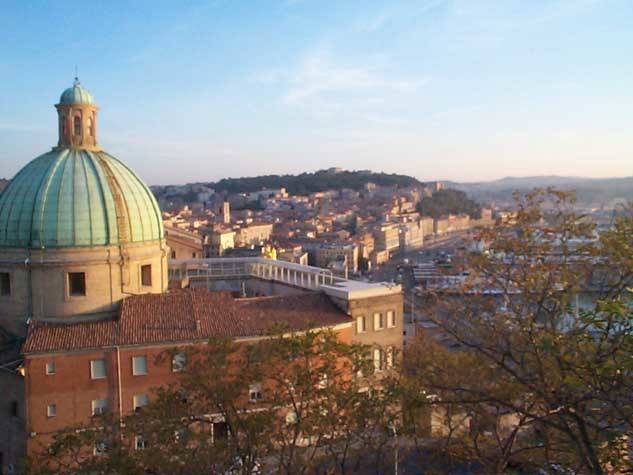Unhurried Steps in the Marches & De Dominicis at MoMA
The Italian vacation has tended to follow a predictable itinerary: Rome, Florence, Venice. Indeed, if anyone had five seconds to name three Italian cities, these would easily spring to mind. But as my parents have always said, in their more sentimental recollections of their native land, all of Italy is beautiful and so much of its beauty has yet to be discovered—in other words, to be discovered on the road least traveled by those unsightly coach buses. The Marches region of Italy (in Italian, “le Marche”) is just as, or more exquisite than any of its better-known counterparts. It’s a scenic land steeped in nature and seascapes, lacking only the recognition of a big-name city. Its capital, Ancona, was more recently the backdrop for “La stanza del figlio”, a film by Nanni Moretti, in which it was made the subject of a study in atmospheric serenity. Ancona’s port of glistening white hulls, tangle of masts and lulling mélange of seagulls and stevedores provided the idyllic setting for Moretti’s early-morning, contemplative jogs, a place upheld as an exemplary of the real Italy. And keeping in mind the hordes of summer tourists that descend on Italy every year, the city and the region’s relative anonymity is ultimately one of its greatest advantages.
Patrizia Casagrande, President of the province of Ancona, said to a gathering at the Italian Tourism Board (ENIT) in New York that “the Marches may not be a region you know very well but that nevertheless has a lot of ambition”. Its ambition was made clear in a presentation rich with images, persuasive of the region’s natural and urban beauties. Perched high above the sea many of the Marches’ small, picturesque towns, like Fano, overlook the Adriatic, along with the entire panoramic area of the Monte Conero. Gradara, a medieval gem, holds special significance for literati: its stunningly preserved castle was the site for Dante’s protagonist lovers, Paolo and Francesca. Places like Urbino, the repository for one of Italy’s greatest collections of Renaissance art, and Corinaldo in the province of Ancona, also stand out as unique and unspoiled representations of medieval architecture. Other lovely destinations of note include Pesaro, Ascoli and Urbisaglio. As Casagrande and her colleague Anna Rita Nicoletti would go on to explain, the Marches is preparing to welcome visitors with an infrastructure, in keeping with the region’s philosophy, that seamlessly blends into the land.
Board (ENIT) in New York that “the Marches may not be a region you know very well but that nevertheless has a lot of ambition”. Its ambition was made clear in a presentation rich with images, persuasive of the region’s natural and urban beauties. Perched high above the sea many of the Marches’ small, picturesque towns, like Fano, overlook the Adriatic, along with the entire panoramic area of the Monte Conero. Gradara, a medieval gem, holds special significance for literati: its stunningly preserved castle was the site for Dante’s protagonist lovers, Paolo and Francesca. Places like Urbino, the repository for one of Italy’s greatest collections of Renaissance art, and Corinaldo in the province of Ancona, also stand out as unique and unspoiled representations of medieval architecture. Other lovely destinations of note include Pesaro, Ascoli and Urbisaglio. As Casagrande and her colleague Anna Rita Nicoletti would go on to explain, the Marches is preparing to welcome visitors with an infrastructure, in keeping with the region’s philosophy, that seamlessly blends into the land.
The region has enjoyed a steady flow of tourists hailing from Holland, Germany and the UK, but hopes to attract from overseas. Most of its accommodations are suited to providing (hard to achieve elsewhere) a unique, local experience: villas, high-end bed and breakfasts and converted farmhouses, which Nicoletti adds, allows one “to live like the farmers do”. Spas, wellness centers, a 49-hole golf course and chateaus-turned-resorts are among the offerings of a more luxurious sort. And the Marches feeds its inhabitants well. White wine, truffles and salamis are some of its specialties, and thanks to a lengthy coastline, exquisite varieties of seafood. The latter is also the land’s lifeblood: Marchigiani are the Italians that live the longest, a fortune surely attributable to their hearty Mediterranean diet. Perhaps long walks along the sea, and hilly panoramas easy on the eyes, don’t hurt either.
For those who may feel trapped in the crowded resorts of the neighboring Romagna region, as I did last summer, an excursion into the Marches will feel more than welcome. Much as I love my grandmother’s house in Riccione, a seaside town in Romagna best known for garish nightclubs, water parks, and shrieking mothers who chide their wailing children at all hours of the afternoon, a trip to the Marches hamlet of Fiorenzuola di Focara was the remedy for my woes. A sloping, airy town with breathtaking views and architectonic splendor (it’s no accident Pavarotti’s villa is located here) I wondered why I hadn’t slipped away to the Marches more often.
To get further insight on this dark horse of Italian regions, at the end of the presentation we spoke to Casagrande and ENIT’s director, Riccardo Strano, also a native of Ancona. Their event was timed with an exhibit of fellow Anconan (and famously reclusive artist) Gino de Dominicis at the P.S. 1 Contemporary Art Center (on view until February 9, 2009).
For starters, how would you describe Gino de Dominicis?
Casagrande: “He’s an extraordinarily unique artist that defies classification… an absolute original. He doesn’t belong to any particular movement. He’s unpredictable. He works in a humorous vein and with complete freedom from established paradigms.”
Strano: “I remember him walking in the streets of Ancona. I was fascinated and intimidated by him!”
This is probably de Dominicis’ first big exhibit stateside, what accounts for the timing?
Casagrande: “We were lucky enough to procure many of his major works from Naples.”
How will the Marches step up its campaign to attract tourism?
Casagrande: “We promote ourselves through culture and music. But of course we want to go beyond that. With natural parks, and young tourists traveling along the coast, we’re also involved in green tourism. What we offer is a vacation that isn’t intended for those attracted to mass tourism.”
What can one expect to do in the off-season?
Casagrande: “The opera season opens and there’s a great deal of religious tourism. Visitors have the chance to stay in one of many beautiful abbeys. There’s also a winter-time agricultural tourism to meditation and yoga centers.”
What else should one know about the Marches?
Strano: “Well, the Marches isn’t attached to a famous city name, like Venice or Florence, but it is certainly economically thriving. What people don’t know is that many of Italy’s major fashion manufacturers are located there, like Prada and Tod’s. The region is also renowned for its yachting industry. And when it comes to tourism, there’s a trend of 'togethering' going on—that is, taking a vacation to get close to your loved ones—and what better place to do that than in a 17th century farmhouse?”
Strano proceeded to show us a thick, Rizzoli-edition tome highlighting Italy’s most spectacular towns. He proudly pointed to the cover: a glossy photograph of Gradara by night, chosen from several cities to represent Italy’s beauty as a whole. We would be remiss in forgetting to mention Giacomelli’s work. The artist is also from the Marches and Strano had his photographs on hand. The black-and-white images of neatly ploughed fields are iconic, but they filled one with a sense of longing, like a call to stay and linger there, in a less harried and simple bucolic setting.
Gino De Dominicis - On view October 19, 2008 - February 9, 2009 more on: PS1 MOMA

Un'opera di Gino De Dominicis





































i-Italy
Facebook
Google+
This work may not be reproduced, in whole or in part, without prior written permission.
Questo lavoro non può essere riprodotto, in tutto o in parte, senza permesso scritto.